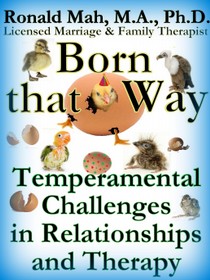Conclusion - RonaldMah
Ronald Mah, M.A., Ph.D.

Licensed Marriage & Family Therapist,
Consultant/Trainer/Author
Main menu:
Conclusion
Therapist Resources > Therapy Books > Born That Way- Termperament Rel

Born that Way, Temperamental Challenges in Relationships and Therapy
CONCLUSION
by Ronald Mah

Children such as Baby 19 may become Aliya married to Samuel and with a son Charlie. A partner like Samuel and a child like Charlie may be the most challenging relationships for Aliya. Yet, such matches are not uncommon to the experienced therapist. The success or failure of adult caregivers to accentuate and develop positive temperamental traits and to mitigate and develop successful compensations for challenging temperamental traits predicts later relationships including as couples and families. Aliya's challenges in the marriage with Samuel and in raising Charlie were predictable. The long-term outcome of the marriage and Charlie's development emotionally, psychologically, academically, and socially are also predictable. Whether well prepared with adequate compensations or further handicapped by highly reactive emotions or dysfunctional behaviors, individuals such as Aliya and Samuel often need the therapist to reapply the principles of support for temperamentally challenged children to the current dynamic. In this family's case, they need the guidance for both the couple's relationship, the family dynamic, and Charlie's development. The therapist will need to be conceptually prepared and temperamentally adept in order to be the good fit the couple and family needs. Conducting a temperamental evaluation may be a valuable component for assessing the dynamics of a relationship, couple, or family. Each individual, partner, or family member has more or less tolerance for behaviors that arise from intrinsic traits versus behaviors that are assumed to be volitional. In addition, intrinsic temperamental traits may range from being highly productive to highly stressful due to behavior and value patterns from diverse family-of-origin models and/or from diverse cultural experiences, intrinsic temperamental traits. This may have caused intellectual, emotional, psychological, and relational stress and problematic compensation during childhood that may be brought into newer relationships. Or, otherwise previously adaptable temperament/cultural patterns may cause conflict with the new person. As a result, temperamental conceptualization should be among the therapeutic lens of the sophisticated and thorough therapist.
And, what about Teri? True to initial temperament- her screaming at the nurse, Teri was the "passionate" child in the family. She was born that way! She felt intensely no matter what the emotion. When she was happy, the whole world was a joyous place. Everyone was enlivened and enlightened with her energy. When she was sad, the whole world was a miserable place. Sorrow dripped from the walls, and everyone was hard pressed not to absorb a depressed mood. When she was mad… watch out! Fortunately, her parents understood and accepted that her in-born temperament was not a choice to be difficult for others. They received professional guidance regarding temperamental theory, including referral to the research of Chess and Thomas. Within her temperamental process, they guided her to healthy socially appropriate choices. She was allowed to feel and express honestly within the full spectrum of her emotions, but not to be intrusive to others. To feel deeply, but never take any entitlement to strike out or harm anyone else. Teri got constant feedback as to her nature- her temperament that created advantages and challenges to her. She also got clear boundaries and consequences for expressing and behaving appropriately. Her parents monitored her more vigilantly when she was younger and had little or no ability to be really self-aware of her moods and inclinations. Then they told her- that is, regulated her what to do and how to do it to be appropriate and successful with her challenges. All along they gave clear feedback of their acceptance and understanding of her temperamental qualities and why certain responses were best and others problematic. With this educational discipline, Teri was gradually able to better self-monitor herself (relieving the parents of the need to scrutinize her process) and self-regulate (further relieving the parents of the need to tell her what to do). Two epochal events told them that she had internalized a sound sense of herself temperamentally and could adequately respond to her challenges.
After years of being told that she was tired and needed nap, Teri did something remarkable at four years of age. Almost every time as her parents monitored her level of fatigue and sagging energy, the regulation or directive to take a nap ignited a protest if not a tantrum. "I don't want to nap! I don't need to nap!" she screamed. Forced nevertheless to lie down in bed, Teri would fall asleep almost immediately every time. Over these early years, the parents had repeatedly told her, "You're getting tired. You need a nap. You won't be happy… you'll be tired and grumpy if you don't nap. You won't be nice to anyone and they or we won't be very nice to you when you're so grumpy. Come on honey, you'll feel better after you've had a nap." Protest and arguments diminished over time as she eventually learned that there was no negotiation. Co-operate and nap. Fight and still nap. Argue and still nap. Nap. Then one day when she was a bit past four years old, she came into the kitchen and announced, "Mommy, Daddy, I'm tired. I need to go nap." "OK," responded the parents, "that's a good idea." As she trundled off to nap on her own, the parents looked at each other wide-eyed and whispered. "Is that really Teri? She finally got it." Teri had self-monitored her energy- felt tired, and had self-regulated herself with a voluntary nap.
Several years later when she was in high school, she acquired a boyfriend. A nice kid… very sweet. It seemed like a very nice relationship from all that the rest of the family observed. A few months into the relationship, her older sister Shay confided in their father. "Hey Dad. You know what I did? When Amit came over the other day to pick up his books he had left… Teri wasn't home. I decided to warn him about Teri." The dad was concerned. Meddling in your sister's, much less your daughter's relationship seemed risky… especially with intense Teri. "No Dad, I didn't say anything bad about Teri," said Shay. "I just told Amit, if Teri has a problem, don't… DON'T try to help her. That is the wrong way. Don't try to fix it or give her any suggestions. She's talking out loud and don't really want any help. It's just her way. If you try to tell her what to do, she'll rip your head off! She'll get mad at you. Let her do her process. And then eventually, she'll come up with what she's going to do… make a decision. That's how she is. THEN, you can say 'OK,' or 'That sounds good.' You got it? Don't try to help!" Dad thought this was delightfully funny. Not only had they been teaching Teri about who she was, but had also been teaching Shay about Teri. It had helped Shay understand, accept, and relate better with Teri over the years. Holding this sisterly "intervention" was just too hilarious to hold to himself. After a week or so, Dad could not resist teasing Teri and telling her what Shay had done. Rather than being angry or even mildly upset about Shay warning her boyfriend about her, Teri declared emphatically, "That's what I told him myself!" Wow! Teri had internalized her temperament and personality consciously. Without parental (or sisterly) advice had known that it could potentially harm her relationship with her boyfriend Amit. Instead of waiting for her inevitably enticing Amit into "helping" her with her animated processing and getting into an argument, she had made a pre-emptive revelation to him about her process. Teri and Amit getting into conflict if unprepared was predictable. Rather than suffering misunderstanding and hurt feelings, Teri had self-monitored, self-regulated, and guided her boyfriend to what works for her when she is intensely involved with some issue to prevent problems. As the parents had taught her sister and her about her temperament and potential problems, Teri had taught her boyfriend about herself. In all teachings, relationships and functioning was benefited.
The parental process of monitoring and regulating Teri and Shay differed as the two girls were different. Teri's temperament had more potential to become problematic, but with informed guidance the rough edges of her temperamental challenges were addressed. Teri learned about herself- her temperamental traits much as another child learned about being diabetic and what it would take to for effective self-care. As a diabetic learns what to do and what not to do for self-care, Teri learned what to do and not to do for self-care in relationships and her personal well-being. Instead of an angry out of control child, Teri became the fun passionate friend, sister, daughter, employee, and girlfriend who others enjoyed. She kept permission and practiced expressing herself authentically which enhanced her self-esteem. Over the years, she had learned how to modulate herself while remaining true to herself. As a result, her animated interactions were well received. In her search for a career, Teri continued to consider the fit between her temperament with the requirements and demands of one path versus another. She had been "born that way" and as her parents understood and accepted her temperament, they guided her in a matching "way" that mitigated her challenging traits and accentuated positive traits.
As a young adult now, Teri's self-awareness and ownership of her temperament continues to successfully guide her responses to her life challenges and relationships… and in her marriage with their three children. One of those children- Dikembe, by the way seems to be also "born that way!" For Dikembe, being "born that way" is not for him as it was not for Teri a prediction of being "doomed that way." Teri is an example of someone with at least some difficult or challenging temperament traits who predictions could have posited a dismal childhood and adult outcome. Teri self-awareness of her journey offers guidance to helping her son manage the temperamental potholes in his path. For Teri's original family, also relevant was that temperamental analysis and awareness helped Teri's parents better understand Shay, as well as shed light on their relationship dynamics as a couple. Understanding provided the guidance for anticipating various challenges and fostering much more positive outcomes in their multiple family relationships. And offered further perspective and direction for their relationships outside of the family. Among other conceptualizations and tools, the therapist can use temperamental theory as a significant lens in individual, couple, and family therapy.

